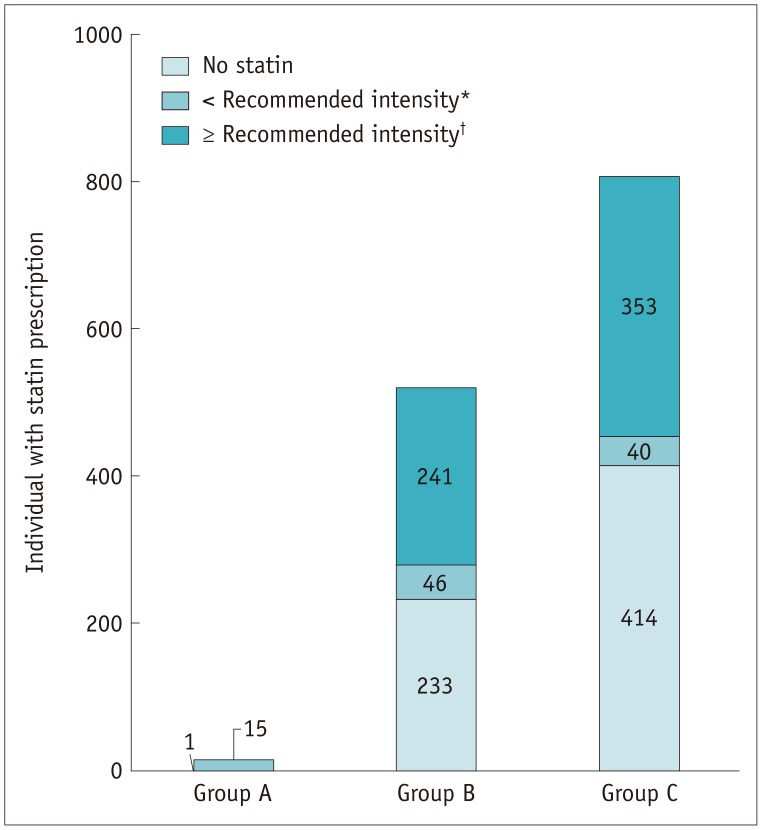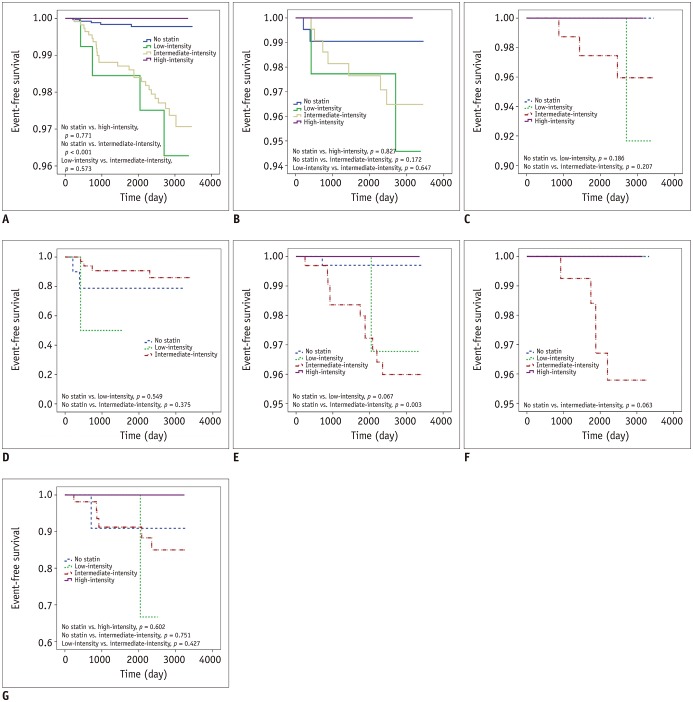Korean J Radiol.
2019 Jul;20(7):1156-1166. 10.3348/kjr.2018.0016.
Subclinical Coronary Atherosclerosis: Implication of Coronary Computed Tomography Angiography Findings among Statin Candidates according to the 2013 ACC/AHA Cholesterol Management Guidelines
- Affiliations
-
- 1Department of Radiology, Seoul National University Bundang Hospital, Seongnam, Korea. drsic@hanmail.net
- KMID: 2467026
- DOI: http://doi.org/10.3348/kjr.2018.0016
Abstract
OBJECTIVE
To analyze the cardiovascular outcome of statin medication in individuals retrospectively categorized on the basis of the 2013 American College of Cardiology and American Heart Association (ACC/AHA) guidelines risk assessment and to determine the additional prognostic value of coronary computed tomography angiography (CCTA) in assessing cardiovascular disease (CVD) risk in this group.
MATERIALS AND METHODS
This retrospective study reviewed 4255 asymptomatic individuals who had undergone self-referred CCTA with a median follow-up period of 87 months. The primary endpoint was major adverse cardiac events (MACEs); these included cardiac death, nonfatal myocardial infarction, and unstable angina. Individuals recommended for statins according to the ACC/AHA guidelines were analyzed by their assessed risk.
RESULTS
MACE occurrence was significantly higher in the statin-recommended (SR) group with significant coronary artery disease (CAD) than in those with insignificant CAD (p < 0.001). In individuals with a normal coronary artery on CCTA, MACEs did not occur regardless of statin medication. In the SR group with significant CAD, there was no significant difference between statin users and non-users (p = 0.810). However, in cases with insignificant CAD, the event-free survival was significantly lower among statin users (p = 0.034). In patients recommended for moderate-intensity statins, the segment involvement score on CCTA was significantly associated with a higher risk of MACEs (hazard ratio 2.558; p = 0.001).
CONCLUSION
CCTA might have a potential role in CVD risk stratification among asymptomatic statin candidates.
MeSH Terms
-
American Heart Association
Angina, Unstable
Angiography*
Atherosclerosis
Cardiology
Cardiovascular Diseases
Cholesterol*
Coronary Artery Disease*
Coronary Vessels
Death
Disease-Free Survival
Follow-Up Studies
Humans
Hydroxymethylglutaryl-CoA Reductase Inhibitors*
Myocardial Infarction
Retrospective Studies
Risk Assessment
Cholesterol
Figure
Reference
-
1. WHO. Global status report on noncommunicable diseases 2014. Geneva: World Health Organization;2014.2. Cook NR, Buring JE, Ridker PM. The effect of including C-reactive protein in cardiovascular risk prediction models for women. Ann Intern Med. 2006; 145:21–29. PMID: 16818925.
Article3. Wang TJ, Gona P, Larson MG, Tofler GH, Levy D, Newton-Cheh C, et al. Multiple biomarkers for the prediction of first major cardiovascular events and death. N Engl J Med. 2006; 355:2631–2639. PMID: 17182988.
Article4. Zethelius B, Berglund L, Sundström J, Ingelsson E, Basu S, Larsson A, et al. Use of multiple biomarkers to improve the prediction of death from cardiovascular causes. N Engl J Med. 2008; 358:2107–2116. PMID: 18480203.
Article5. Greenland P, LaBree L, Azen SP, Doherty TM, Detrano RC. Coronary artery calcium score combined with Framingham score for risk prediction in asymptomatic individuals. JAMA. 2004; 291:210–215. PMID: 14722147.
Article6. O'Leary DH, Polak JF, Kronmal RA, Savage PJ, Borhani NO, Kittner SJ, et al. Cardiovascular Health Study Collaborative Research Group. Thickening of the carotid wall. A marker for atherosclerosis in the elderly? Stroke. 1996; 27:224–231. PMID: 8571414.7. Wild SH, Byrne CD, Smith FB, Lee AJ, Fowkes FG. Low ankle-brachial pressure index predicts increased risk of cardiovascular disease independent of the metabolic syndrome and conventional cardiovascular risk factors in the Edinburgh Artery Study. Diabetes Care. 2006; 29:637–642. PMID: 16505519.
Article8. Hulten EA, Carbonaro S, Petrillo SP, Mitchell JD, Villines TC. Prognostic value of cardiac computed tomography angiography: a systematic review and meta-analysis. J Am Coll Cardiol. 2011; 57:1237–1247. PMID: 21145688.9. Hou ZH, Lu B, Gao Y, Jiang SL, Wang Y, Li W, et al. Prognostic value of coronary CT angiography and calcium score for major adverse cardiac events in outpatients. JACC Cardiovasc Imaging. 2012; 5:990–999. PMID: 23058065.
Article10. Pundziute G, Schuijf JD, Jukema JW, Boersma E, de Roos A, van der Wall EE, et al. Prognostic value of multislice computed tomography coronary angiography in patients with known or suspected coronary artery disease. J Am Coll Cardiol. 2007; 49:62–70. PMID: 17207724.
Article11. Motoyama S, Kondo T, Sarai M, Sugiura A, Harigaya H, Sato T, et al. Multislice computed tomographic characteristics of coronary lesions in acute coronary syndromes. J Am Coll Cardiol. 2007; 50:319–326. PMID: 17659199.
Article12. Min JK, Shaw LJ, Devereux RB, Okin PM, Weinsaft JW, Russo DJ, et al. Prognostic value of multidetector coronary computed tomographic angiography for prediction of all-cause mortality. J Am Coll Cardiol. 2007; 50:1161–1170. PMID: 17868808.
Article13. Stone NJ, Robinson JG, Lichtenstein AH, Bairey Merz CN, Blum CB, Eckel RH, et al. 2013 ACC/AHA guideline on the treatment of blood cholesterol to reduce atherosclerotic cardiovascular risk in adults: a report of the American College of Cardiology/American Heart Association Task Force on Practice Guidelines. J Am Coll Cardiol. 2014; 63(25 Pt B):2889–2934. PMID: 24239923.14. Pencina MJ, Navar-Boggan AM, D'Agostino RB Sr, Williams K, Neely B, Sniderman AD, et al. Application of new cholesterol guidelines to a population-based sample. N Engl J Med. 2014; 370:1422–1431. PMID: 24645848.
Article15. Goff DC Jr, Lloyd-Jones DM, Bennett G, Coady S, D'Agostino RB, Gibbons R, et al. 2013 ACC/AHA guideline on the assessment of cardiovascular risk: a report of the American College of Cardiology/American Heart Association Task Force on Practice Guidelines. Circulation. 2014; 129(25 Suppl 2):S49–S73. PMID: 24222018.
Article16. Maurovich-Horvat P, Hoffmann U, Vorpahl M, Nakano M, Virmani R, Alkadhi H. The napkin-ring sign: CT signature of high-risk coronary plaques? JACC Cardiovasc Imaging. 2010; 3:440–444. PMID: 20394906.
Article17. Nasir K, Bittencourt MS, Blaha MJ, Blankstein R, Agatson AS, Rivera JJ, et al. Implications of coronary artery calcium testing among statin candidates according to American College of Cardiology/American Heart Association cholesterol management guidelines: MESA (Multi-Ethnic Study of Atherosclerosis). J Am Coll Cardiol. 2015; 66:1657–1668. PMID: 26449135.18. Johnson KM, Dowe DA. Accuracy of statin assignment using the 2013 AHA/ACC cholesterol guideline versus the 2001 NCEP ATP III guideline: correlation with atherosclerotic plaque imaging. J Am Coll Cardiol. 2014; 64:910–919. PMID: 25169177.19. Naghavi M, Falk E, Hecht HS, Jamieson MJ, Kaul S, Berman D, et al. From vulnerable plaque to vulnerable patient--Part III: executive summary of the Screening for Heart Attack Prevention and Education (SHAPE) Task Force report. Am J Cardiol. 2006; 98(2A):2H–15H.
Article20. Pursnani A, Massaro JM, D'Agostino RB Sr, O'Donnell CJ, Hoffmann U. Guideline-based statin eligibility, coronary artery calcification, and cardiovascular events. JAMA. 2015; 314:134–141. PMID: 26172893.
Article21. Jung CH, Lee MJ, Kang YM, Yang DH, Kang JW, Kim EH, et al. 2013 ACC/AHA versus 2004 NECP ATP III guidelines in the assignment of statin treatment in a Korean population with subclinical coronary atherosclerosis. PLoS One. 2015; 10:e0137478. PMID: 26372638.
Article22. Chow BJ, Small G, Yam Y, Chen L, McPherson R, Achenbach S, et al. CONFIRM Investigators. Prognostic and therapeutic implications of statin and aspirin therapy in individuals with nonobstructive coronary artery disease: results from the CONFIRM (COronary CT Angiography EvaluatioN For Clinical Outcomes: An InteRnational Multicenter registry) registry. Arterioscler Thromb Vasc Biol. 2015; 35:981–989. PMID: 25676000.23. Hwang IC, Jeon JY, Kim Y, Kim HM, Yoon YE, Lee SP, et al. Statin therapy is associated with lower all-cause mortality in patients with non-obstructive coronary artery disease. Atherosclerosis. 2015; 239:335–342. PMID: 25682032.
Article24. Schulman-Marcus J, Hartaigh BÓ, Giambrone AE, Gransar H, Valenti V, Berman DS, et al. Effects of cardiac medications for patients with obstructive coronary artery disease by coronary computed tomographic angiography: results from the multicenter CONFIRM registry. Atherosclerosis. 2015; 238:119–125. PMID: 25479800.
Article25. Hulten E, Bittencourt MS, Singh A, O'Leary D, Christman MP, Osmani W, et al. Coronary artery disease detected by coronary computed tomographic angiography is associated with intensification of preventive medical therapy and lower low-density lipoprotein cholesterol. Circ Cardiovasc Imaging. 2014; 7:629–638. PMID: 24906356.
Article26. Grundy SM, Stone NJ, Bailey AL, Beam C, Birtcher KK, Blumenthal RS, et al. 2018 AHA/ACC/AACVPR/AAPA/ABC/ACPM/ADA/AGS/APhA/ASPC/NLA/PCNA guideline on the management of blood cholesterol: executive summary: a report of the American College of Cardiology/American Heart Association Task Force on Clinical Practice Guidelines. J Am Coll Cardiol. 2018; pii: S0735-S1097(18)39033-39038.
- Full Text Links
- Actions
-
Cited
- CITED
-
- Close
- Share
- Similar articles
-
- Statin Therapy with Coronary Plaque Imaging
- Reassessment of Inclusion Criteria in the 2013 the American College of Cardiology and the American Heart Association Cholesterol Guidelines for Cardiovascular Disease Prevention
- Current Guidelines on the Management of Dyslipidemia
- 2013 ACC/AHA Guidelines
- Recent Guidelines on the Management of Blood Cholesterol: 2013 ACC/AHA Guidelines and 2014 NICE Draft Guidelines




